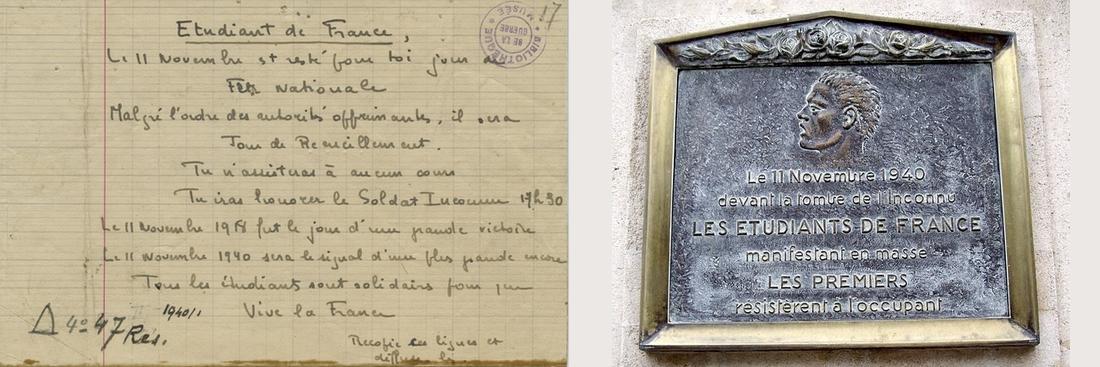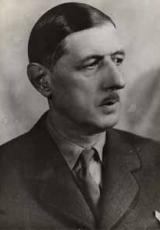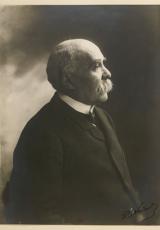Le 11 novembre 1940

Corps 1
14th June 1940: after five weeks of fighting, France was struggling. The Germans had reached Paris, declared an open city. On the 17th June, Marshal Pétain ordered a cease fire and on the 22nd June an armistice was signed.
Corps 2
At the end of the summer, Parisian refugees returned and the occupied French capital saw a gradual increase in activity. With the school holidays over, lessons started again in the schools, colleges and universities. Life was seemingly beginning to return to normal. The main concern for Parisians was how to adapt to the new situation. Although the very first resistance movements were starting to appear, most of those who believed they "had to do something" had not yet found a way of putting their ideas into action. It was the same situation in student and teaching circles, where the enemy presence in the capital brought about rejection for a variety of reasons, arising, on the right, from the drama provided by the tragedy and national humiliation, and on the left, from the suppression of liberty and the abhorrent rule of fascism, the position of the communist students being much clearer than that of the party.
So the men and women who became involved in the action came from backgrounds as diverse as Roger Morais, from the arts society, one of the founders in September of the Maintenir (Support) group; Philippe Viannay, a philosophy student and Robert Salmon, a pupil at the Louis-le-Grand high school who, along with Hélène Mordkovitch, a librarian at the faculty of sciences, were to be responsible for the Defence of France movement which was born in the winter of 1940-41; Jean Ebstein, a sympathiser of "French Action" who, with his friends turned the committee of the Law Students' Society into an opposition group; Claude Lalet, a history student who united communist students in drafting propaganda leaflets and writing the secret newspaper, La Relève (The Relief). In this atmosphere, the traditionally recalcitrant student sector became restless: walls were daubed with "V" for "Victory", "Long live de Gaulle" was shouted in the corridors of the underground and propaganda leaflets were dropped in lecture halls... Incidents and even brawls sometimes broke out between youths and German soldiers. After the publication of the order on the 3rd October excluding Jews from the teaching profession in accordance with the Statute on Jews, teachers demonstrated their sympathy for their ousted colleagues. The meeting on the 24th October in Montoire between Hitler and Marshal Pétain and the speech made on the 30th October which included the word "collaboration", caused unrest amongst those who had trusted the Head of the French State.
On the 30th October the same year, Professor Langevin - a renowned physicist and founder in 1934 of the Antifascist Intellectuals Vigilance Committee - was arrested and interned. In response, on the 8th November, students close to the French Communist Party demonstrated in front of the Collège de France where the academic taught. On the 28th October the chief of police, Langeron, wrote: "They're talking about demonstrating on the 11th November. (..) Montoire has already achieved one result, that of stimulating Gaullist propaganda amongst students". The date of the 11th November was symbolic: although the Germans were to win on that day, they had been defeated on the 11th November 1918. The celebration of this 22nd anniversary gave Parisians the opportunity to demonstrate their opposition to the enemy and its supporters.
In the first few days of November, propaganda circulated in the Parisian high schools of Janson de Sailly, Carnot, Condorcet, Buffon, Chaptal, Saint-Louis and Henri IV, as well as at the Law Students Society, in the Latin Quarter... Amongst these propaganda leaflets was one emanating from a group linked to the Maintenir network, printed at a Centre providing aid for those students who had been called up and taken prisoner, which called for demonstrations on Armistice day in the Place de l'Etoile at 5.30 pm. In addition, the radio in London, the French voice of the France Libre (Free French), called for the Parisian people to commemorate the victory of 1918 by laying flowers on the statue of Clemenceau and the Tomb of the Unknown Soldier. On the 10th November, Parisian papers published a statement from Police Headquarters stipulating that: "Public services and private businesses will work as usual on the 11th November in Paris and in the Seine département. Commemorative celebrations will not take place. No public demonstrations will be tolerated." In the first few days of November, propaganda circulated in the Parisian high schools of Janson de Sailly, Carnot, Condorcet, Buffon, Chaptal, Saint-Louis and Henri IV, as well as at the Law Students Society, in the Latin Quarter... Amongst these propaganda leaflets was one emanating from a group linked to the Maintenir network, printed at a Centre providing aid for those students who had been called up and taken prisoner, which called for demonstrations on Armistice day in the Place de l'Etoile at 5.30 pm. In addition, the radio in London, the French voice of the France Libre (Free French), called for the Parisian people to commemorate the victory of 1918 by laying flowers on the statue of Clemenceau and the Tomb of the Unknown Soldier. On the 10th November, Parisian papers published a statement from Police Headquarters stipulating that: "Public services and private businesses will work as usual on the 11th November in Paris and in the Seine département. Commemorative celebrations will not take place. No public demonstrations will be tolerated."
A notice banning demonstrations on the 11th November was posted in all the schools and faculties in Paris, with very clear instructions to Academy inspectors and headmasters. This banning order resulted in a spontaneous movement against the injunction pronouncing it tantamount to bullying. The initiatives launched for the 11th November came from small groups, often without any links between them but with the same aims, influencing crowds of young people seeking primarily to defy the occupying forces.
At the same time they were defying the instructions of the 10th November, the German order of the 20th June 1940 banning demonstrations and Article 4 of the government decree of the 23rd October threatening criminal charges against those taking part in undeclared or banned demonstrations. The authorities were wary of the possible reaction of young people. On the morning of Monday 11th November, police officers visited Parisian schools but noticed nothing unusual. However, at around 5.30 am, André Weil-Curiel, Michel Edinger and Léon-Maurice Nordmann, members of an opposition group that included lawyers, teachers and intellectuals, hurriedly placed a wreath at the foot of the statue of Georges Clemenceau on the Champs-Élysées, "As a token of admiration to the man who would never capitulate and never gave up hope for his Homeland". The wreath was bound with a red white and blue ribbon and accompanied by a large calling card in the name of General de Gaulle. The card and ribbon disappeared during the morning, but anonymous hands continued to place bouquets next to the wreath. Towards midday, around a hundred youths wearing red white and blue rosettes confronted police on the Champs-Elysées. A teacher who intervened was arrested. Between 4.30 and 5.30 pm, as lessons ended, pupils, students and teachers mingled with the people strolling down the main street, along with those who had played truant.
Parisians converged on the Champs-Elysées et la Place de l'Etoile. They came on their own, in small groups, in processions that were quite dense one minute and fragmented the next, before reforming once more. Processions came from the high schools of Carnot, Buffon and Janson de Sailly etc. In this last establishment, the pupils had organised a collection to buy a wreath, which the florist chose to make in the shape of a Cross of Lorraine. Shortly before 4 pm two pupils, Schotten and Dubost, placed it on the Tomb of the Unknown Soldier, with the tacit permission of police officers, before rejoining their school friends. This wreath joined several bouquets and a few other wreaths, one of which was in the colours of Belgium. The demonstrators provided a wide political sample, from the royalist sympathiser Alain Griotteray to the Guadeloupe communist party supporter Tony Bloncourt, to school pupils and students, as well as teachers like Edmond Lablénie, from Janson de Sailly and Raymond Burgard, from Buffon. The crowd continued to grow on the Champs-Elysées and was estimated at between 3,000 and 5,000 people. As night fell, processions marched along the whole avenue, dispersing and regrouping according to the intervention of the police.
Some demonstrators, wearing black ties, sported red white and blue ribbons or wore the cross of Lorraine in their buttonhole. The student spirit inspired some to brandish two fishing rods to the cry of "Long live" followed by a brief silence ("deux gaules" - meaning two fishing rods, a play on words for "de Gaulle"), to the smiles of passers-by. Tricolour flags appeared. Half-heartedly pursuing the demonstrators, the police were happy just to channel the crowd or advise the youths to clear off. Cries soon started to ring out from the crowds: "Long live France", "Down with Pétain", "Down with Hitler"... Here and there the Marseillaise and the Chant du Départ (Song of the Departure) broke out. Those most surprised were probably the Germans posted in the cafés or stationed in cinema foyers.
Whilst bouquets were still being placed on the Tomb of the Unknown Soldier, further down in front of the head offices of two collaborationist organisations fights were breaking out. The Germans intervened and arrested some of the students. Towards 6pm soldiers of the Wehrmacht, armed with pistols, machine guns and grenades cleared the Champs-Elysées and the Place de l'Etoile Wehrmacht, violently dispersing the demonstration. Whilst some soldiers charged from Avenue Georges V to the roundabout on the Champs Elysées wielding clubs and pistol grips, others fired randomly at the crowd, as military vehicles swept the pavements by driving in zigzags. It was utter confusion. The police closed off access to the Arc de Triomphe. Having emptied the Champs-Elysées, German soldiers charged on the crowd that had gathered in the Place de l'Etoile, pursuing those who were fleeing down rue Tilsitt and rue Galilée. Police vans and military lorries arrived in numbers. Less than thirty minutes later, the area around the Place de l'Etoile was deserted of all demonstrators. Some groups of students continued to demonstrate around the Place de la Concorde; clashes carried on until around 7 pm. At about 6.30 pm, as had been the custom since 1923 and despite the events of the day, the Flame of Remembrance was rekindled by the Committee in front of around a hundred people.
The following day, the radio from London was to tell of the deaths of several demonstrators. In fact, there had only been a few people injured, some of which were certainly serious, and some arrests. The exact number of arrests was difficult to establish. Paris Police Headquarters records listed 105 names (93 students and high school pupils, 1 teacher, 11 people of various professions and older than the students, including 4 women); a statement by the Vice Presidency of the Council dated 8th December 1940, listed 123 arrests including 104 students and pupils. A statement by the German military Commander in France on the 13th December referred to the arrest of 143 students. The new Education Officer, Jérôme Carcopino, suggested the number of students arrested was 150.
Many of them had a short stay in a police station. Others were taken to the prisons of Cherche-Midi and la Santé, beaten and incarcerated. Most of them would be released in the weeks that followed. At the end of 1940, such leniency can only be explained by the desire not to damage the image of the policy of collaboration, which both the German authorities and the Pétainist government were trying to maintain. The first large-scale evidence of Parisian opposition to the occupying forces, the demonstration on the 11th November 1940, is today seen as the first collective act of resistance. Led for the most part by school pupils and students, a certain amount of romanticism certainly played its part in the action. But in demonstrating against the Germans, the intellectual youth had first and foremost demonstrated its determination to fight for freedom. Coming less than three weeks after the meeting in Montoire, the event was significant.
Besides, this demonstration shocked the Vichy government, who wanted to rally young people to its programme. On the 13th November, the University of Paris and around thirty other higher educational establishments were closed (they would reopen before the Christmas holidays). Gustave Roussy, the Education officer for the University of Paris, was dismissed and replaced by Jérôme Carcopino. Placing the Latin Quarter under close surveillance, on the 21st November the German authorities carried out preventative arrests - more than a thousand, and just for a few hours. Parisian newspapers would not mention the demonstration, either directly or indirectly, until after the 15th November and it was only on the 8th December that they published a government statement giving an "official account" of the demonstrations. From London; where news had just arrived that the Gabon had joined the France Libre cause, the Parisian demonstration was seen as an opportune sign of encouragement for General de Gaulle.
The day after the event many students, fearing for their education, opted to concentrate on their studies as soon as courses started again. But others, encouraged by their own audacity and shocked by the disproportionate repression, went on to join the resistance movement.
They would secretly form small groups who would gradually form relationships with the large resistance movements, beginning their action by printing and distributing leaflets and newspapers and following this with forging papers and recovering and hoarding weapons etc. Whilst some demonstrators would go on to join resistance networks, others chose to enlist in the ranks of the France Libre. Parisians were not the only ones to have demonstrated on the 11th November 1940. Rouen and Dijon witnessed an explosion of red white and blue ribbons and in Nantes a French flag was hoisted on the cathedral. There was industrial action in the coal mines in the Nord département. Throughout the whole of the Second World war, the date of the 11th November, which was incidentally always celebrated by the official authorities, would give rise to symbolic gestures, of which the most famous was the parade by members of the Resistance ("maquisards") in Oyonnax in 1943.




